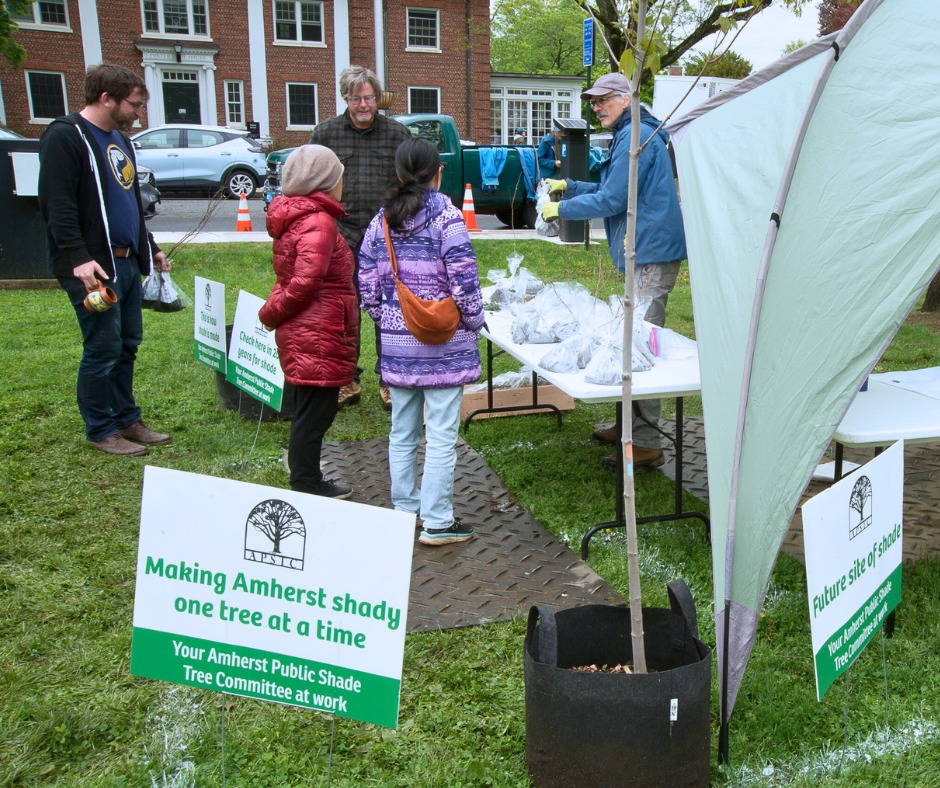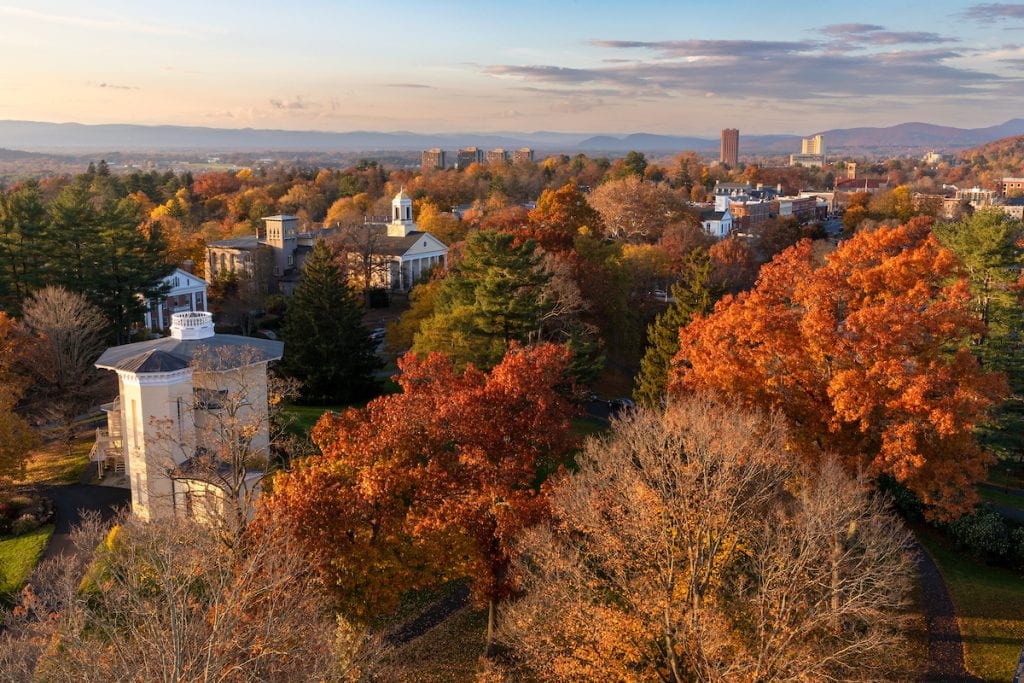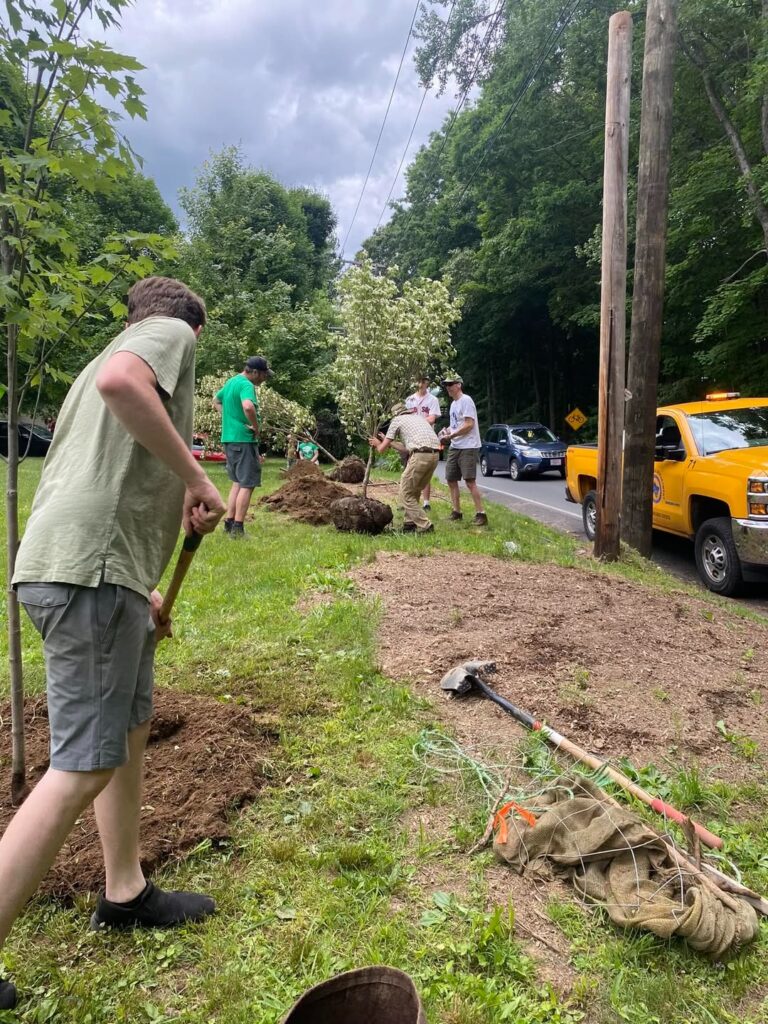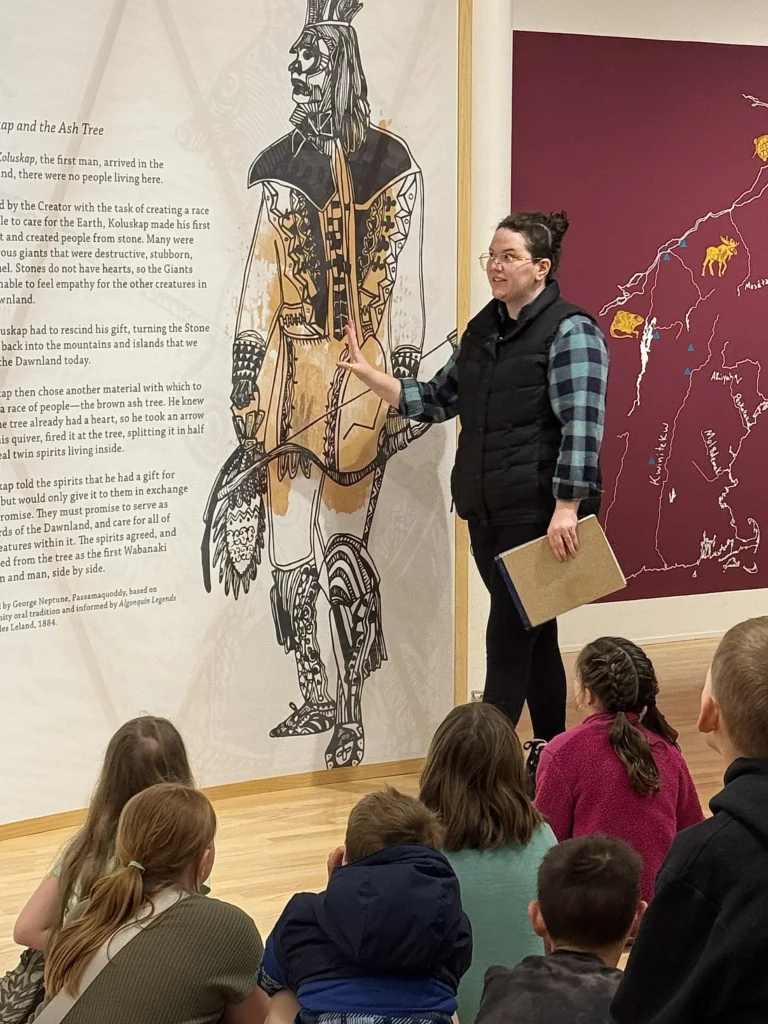View on Views: The Work of Our Shade Tree Committee – Making Amherst Greener, Cooler, and More Beautiful

The APSTC publicizing their work at Amherst Farmers Market. Photo: APSTC Facebook
By Hetty Startup
This is the second installment of View on Views, a series of 10 columns about landscape design in Amherst. Read the first installment here. This time I want to feature trees as the key design element and the work of the town’s Public Shade Tree Committee in helping to create a greener, cooler, and more beautiful town for all of us. In a warming world, places like Amherst can be an oasis where townsfolk have creatively added more shade to lessen the harm of what are known as ‘heat island effects.’ These are places that have warmed more intensively than surrounding rural areas and where air-conditioners, furnaces and heat from vehicles tend to trap the heat in a more concentrated way in places like a downtown. A good example of a place that achieves this amelioration is at Sweetzer Park.

It is the Amherst Public Shade Tree Committee’s (ASPTC) mission to preserve and protect the town’s trees, ensuring that shelter is available in the form of tree canopies that can help to lower temperatures, improve air quality, reduce our energy consumption and boost both the physical and mental health of our neighbors and fellow residents. I had hoped to link Indy readers to the U.S. Forest Service for more information about this very topic, but the Forest Service webpage is currently unavailable because of the government shutdown.

The Amherst Shade Tree Committee
Our Shade Tree Committee advocates for specific design standards when applied to trees and our townscape. This is evident in this quote from the Amherst Bulletin this past January:
The Amherst Public Shade Tree Committee would like to express our belief that Amherst must create zoning regulations that encourage space for trees and pedestrians…preserv[ing] frontage space adequate for mature trees in downtown and village centers. When buildings are set too close to roads—as seen downtown at apartment complexes on Triangle and Spring Streets—the resulting environment becomes harsh and unfriendly. The public sidewalks are pushed against tall buildings and there is insufficient land to support mature shade trees. Even if trees and shrubs are planted, they may not survive where the space is inadequate.
We would like Amherst to continue to be a warm, welcoming environment for all. So we urge the town to ensure that all future building allows for tree-lined streets and wide, comfortable walking space. It is well documented that urban spaces with ample trees are cooler, quieter and more inviting. Trees tend to facilitate cleaner air and soften traffic noise. People are more likely to walk, shop and spend time in areas with tree canopy. That is the environment we hope Amherst will maintain. Trees, shrubs and plants, especially natives, also help nurture birds, butterflies, bees and other pollinator species that are critical for a healthy ecosystem. They often serve as an important protection against floods.
The APSTC is a volunteer committee (much like other commissions and committees in our town) and it is served by Alan Snow, the town’s Tree Warden. So when residents or public officials and town request modifications to plans or designs or architectural schemes, the Tree Warden may play a large role (such as in the recently finished town common project) but the APSTC can act in a very important role as well. Other organizations can be crucial in helping to shape the “greener” look of Amherst . The Indy itself has been a voice in these discussions and has several people better versed than me in making assessments. Instead what I would like to do here is document what the committee has been doing for the past couple of years to create more shade in our town, and also offer more beautiful edges to sidewalks and roads in our neighborhood. In June 2024, they planted trees on Stanley Street, as well as Northampton Road, and Snell Street.

In September 2024, a similar group planted trees at Gatehouse Road in the Echo Hill neighborhood. And more trees appeared on West Street in May of this year. In February, on Tu bishvat (the Jewish New Year observance for Trees), the committee pledged to plant trees every second Saturday. The tradition is experienced differently depending on where you live in the world but sometimes there is a special seder where a family might try a new fruit or plan to plant a tree. Observers also show appreciation for all of the things that trees do for us.
The work of the committee was represented at a recent Cuppa Joe with Town Manager Paul Bockelman by Tree Warden Alan Snow. Snow also works closely with the Town’s Department of Public Works (DPW) and has been a major player in the redesign of the North Town Common. Related to that project, members of the Committee were out planting the new gardens in front of Town Hall in April 2024 (so that they look well-established this year). Come September they were found on Farmington Road and PondView Drive (in the Orchard Valley neighborhood) planting trees there. And a few weeks ago, they planted three trees on the Town Common and more along Amity Street.
In the decades since the Amherst Shade Tree Committee was formed, in 1977, there have been some long-time members like Henry Lappen (who also juggles for a living) and local authors like Britt Crow-Miller, who writes children’s books about trees and nature more generally. I am thinking of her book, Thank You Old Oak. On behalf of the town (that’s us) the APSTC maintains a nursery where they also offer planting sessions and these are usually held in November before the snow flies or before there has been a series of killing frosts.
The Shade Tree Committee also helps spread the word about the value of trees by sponsoring talks or connecting their followers to ones organized by other organizations. Last year, the Amherst Historical Society’s History Bites Program offered one about the Old Grove at UMass that took the form of a talk and also a walk through the grove near Orchard Hill. [
The committee acts as a resource for sharing information about what to do with fallen leaves, how to prune, and how to handle the impact of droughts in Western Mass such as the one this year. They are on top of relevant books or TV programming that pertains to trees. In addition to APSTC regular and special events, the committee offers advice about how to rid trees of invasive vines or how to protect the town’s and the residents’ trees from the effects of climate change. On their social media page they share worries or concerns about lantern bug infestations or stopping the emerald ash borer.
The Emerald Ash Borer problem
This beetle is an invasive insect that arrived from Asia about twenty years ago. It has caused massive destruction of ash trees all across North America, and it has been discovered that the spread of the problem has been accelerated by the transportation of infected firewood and/or logs.
As experts explain in this link “adult beetles lay their eggs on the bark of the tree, and the hatching larvae bore into the tree to feed on the inner bark. As the larvae feed, they create “S”-shaped galleries, which eventually girdle the tree, effectively killing the tree from the inside out.” Sticking with the topic of ash trees specifically, I was reminded that this tree has special meaning for the “People of the Dawn“ (the Wabanaki) who consider its value in ways that are cultural, spiritual and economic. At the Abbe Museum on Mount Desert Island in Maine, I remember learning about brown ash basket making by local tribes and that the tree plays a key role in Eastern Wabanaki creation myths. This includes the Maine-based Passamaquoddy, Penobscot, Mailiseet and Mi’kmaq Nations

Trees are not only significant for their shade – they are foundational to our existence.
Thanks to the APSTC committee, I have found my way to other programming by related non-profits or government organizations like regular guided walks called the Tree Trek program at the Mt Holyoke Range. In past years, the committee has helped the town to celebrate Arbor Day and Earth Day. Instead of their usual second-Saturday-of-the-month work day in August, it has become a tradition to hold a summer potluck, usually outdoors. The committee members, their families, friends and neighbors also participate in the townwide annual annual sustainability festival on the common as at one of these events that I first encountered members of the committee and heard more about their work. They are often looking for more people to help with the planting sessions.
More Information
FAQs About Public Shade Trees
The Shade Tree Committee gets its trees from a number of sources, including Amherst Nurseries and Sugarloaf Gardens. When participating in a planting, they request that you please bring gloves and shovels if you have them. The committee meets on the second Tuesday of every month and welcomes members of the general public. Its meetings are virtual, and so easy to join, using this link.
Maybe you have your own favorite shady spot in Amherst? Do share in the Comments section.

Your recent piece, “The Work of Our Shade Tree Committee: Making Amherst Greener, Cooler, and More Beautiful,” sparked something creative in me. As someone who composes songs inspired by our town’s news and landscapes, I felt compelled to turn your article into a folk song titled “Amherst in the Shade.” It’s a tribute to the people of Amherst who plant trees, build green spaces, and soften the city’s heat islands one branch at a time.
This song is part of my broader artistic project—a compilation of pieces tied both to the Amherst Indy reportage and my Songs of the Land series—which explores how our community, our environment, and our stories intertwine. You can listen to Amherst in the Shade here: https://soundcloud.com/sweetsongsproject/amherst-in-shade
Thank you for illuminating the local stories that quietly shape our town’s future. Your work continues to inspire music, reflection, and community action.
Thank you, Hetty, for shining a spotlight on the Amherst Public Shade Tree Committee! We are an active committee of volunteers who work hard to plant trees and bring cooling shade to residents across town. We recently redesigned our website and will soon launch a new series of articles featuring different tree species growing in Amherst. We appreciate your excellent reporting and look forward to reading future View on Views.
Ellen Keiter, chair
Amherst Public Shade Tree Committee
• Instagram: amherstshadetreecommittee
• Facebook: https://www.facebook.com/APSTC